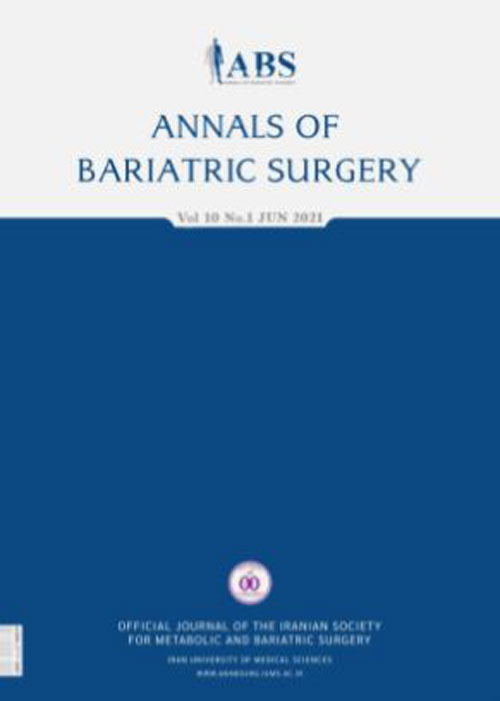فهرست مطالب
Annals of Bariatric Surgery
Volume:4 Issue: 3, Summer 2015
- تاریخ انتشار: 1394/07/25
- تعداد عناوین: 5
-
-
Page 1BackgroundEndometriosis changes the management of infertile women..ObjectivesOur aim was to evaluate some of the clinical predictive factors among an Iranian infertile population..Patients andMethodsInfertile women, scheduled for diagnostic laparoscopy, were recruited into the study and their information including age, weight, height, educational level, marriage and breast-feeding duration, history of fertility, menstrual characteristics, dysmenorrhea, and dyspareunia were collected. Clinical characteristics were then compared with laparoscopic results..ResultsOf 441 infertile women, 82 (18.6%) had endometriosis. No statistically significant difference was identified in the participants’ age, educational level, duration of breast-feeding, duration of infertility, and menstrual flow. On the contrary, women with endometriosis had longer duration of marriage (OR = 1.03, P = 0.002), older age at first pregnancy (OR = 1.21, P < 0.05), lower BMI (OR = 0.9, P = 0.001), shorter interval of menses (OR = 0.98, P < 0.05), and history of irregular menstrual cycles (OR = 0.54, P < 0.05), compared to those without endometriosis. The risk of the endometriosis also decreased significantly with increased numbers of previous pregnancies. The OR for endometriosis in the presence of dysmenorrhea and dyspareunia were 1.80 (1.02 - 3.04) and 1.82 (1.01 - 3.29), respectively..ConclusionsLower BMI, longer duration of marriage, shorter menstrual cycles, dyspareunia, and dysmenorrhea are predictive factors for diagnosis of endometriosis in infertile population. These clinical factors should be considered prior to diagnostic laparoscopy for infertility..Keywords: Endometriosis, Infertility, Diagnosis, Laparoscopy
-
Page 2IntroductionA bilateral anterior parasternal hernia is commonly called a Morgagni-Larrey hernia. Morgagni hernias are rare in adults, accounting for 3% of all treated diaphragmatic hernias. This article reports a giant bilateral Morgagni-Larrey hernia, repaired with a laparoscopic reduced-port technique..Case PresentationAn 83-year-old female was admitted to the general surgery outpatient clinic with gastrointestinal, respiratory symptoms, and retrosternal pain. A computed tomography (CT) scan showed a 12-cm retrosternal hernia defect on the right and a 3-cm defect on the left of the diaphragm The stomach and colon were herniated from the right defect and the omentum was herniated from the left defect to the thorax. The hernia contents were pushed back to the abdomen and the defects were repaired with single sutures through a three-port laparoscopic procedure. A composite mesh material was placed and fixed with pro-tack (Covidien). The patient was discharged on the fourth postoperative day without any complaints..ConclusionsTransabdominal laparoscopic Morgagni-Larrey hernia repairs with reduced number of ports are safe and feasible..Keywords: Morgagni Hernias, Surgery, Laparoscopy
-
Page 4BackgroundPrevious abdominal surgery and its related adhesions are usually a relative contraindication for laparoscopic surgery or reason for conversion..ObjectivesThis study aim to identify patients with previous abdominal surgery and compare the clinical outcomes in patients with and without previous abdominal surgery..Patients andMethodsData was collected prospectively from September 2006 to Dec 2010 of all laparoscopic colorectal resections done for both benign and malignant diseases..ResultsOut of 718 patients 476 had no previous abdominal surgery (Group A), whilst 190 patients had previous abdominal surgery not involving colonic surgery (Group B), and 52 had previous bowel surgery (Group C). The conversion rate was 4% for all groups, the re-admission rate was 11.8% for Group A, 12.6% for Group B and 9.6% for Group C, the median length of stay was 4 days for Groups A and B and 5 days for Group C. There was no statistically significant difference between groups for any of the above measures. However, there was a statistically significant difference in the length of operative time between groups. Patients in Group A and Group B requiring a median of 180 minutes, whilst Group C required a median of 210 minutes of operative time. (P = 0.026 and 0.002, respectively)..ConclusionsPrevious abdominal surgery, including previous colonic surgery, confers no added risk of conversion to an open operation, morbidity or mortality for patients undergoing laparoscopic colorectal surgery. The operative time however is longer (30 minutes) for patients with previous colonic surgery..Keywords: Laparoscopic Surgery, Conversion Rates, Previous Abdominal Surgery, Previous Colonic Surgery
-
Page 5BackgroundBariatric surgery’s efficacy in morbid obesity therapy has been proven; but post-operational zinc deficiency is a problematic issue as its essential role in post-operational recovery of patients..ObjectivesThe aim of this study is to evaluate the rate of zinc deficiency in Iranian morbidly obese candidates for bariatric surgery..Patients andMethodsWe assessed zinc status in 996 morbidly obese subjects (BMI > 40 kg/m2 or BMI > 35 kg/m2 with any comorbidities) (841 females, 155 males) who were candidate for bariatric surgery. Comorbidities related to obesity including dyslipidemia, abnormal fasting glucose, hypertension and type-2 diabetes (T2D) were evaluated. Also we checked albumin and SGPT as markers of liver function. Data analyzed by SPSS..ResultsZinc deficiency was found in 13.6% of patients. Zinc levels had an inverse and significant association with age (P Value = 0.016). Although greater levels of circulating zinc were observed in patients with higher BMI, there were no significant correlation between zinc deficiency and adiposity. Dyslipidemia was found to be the most prevalent comorbidity in this population..ConclusionsThese results show a high prevalence of zinc deficiency in morbidly obese subjects. Thus, we suggest the evaluation of the zinc status in patients undergoing bariatric surgery and treatment of zinc deficiency before doing the surgery..Keywords: Prevalence, Zinc Deficiency, Morbid Obese, Bariatric Surgery


